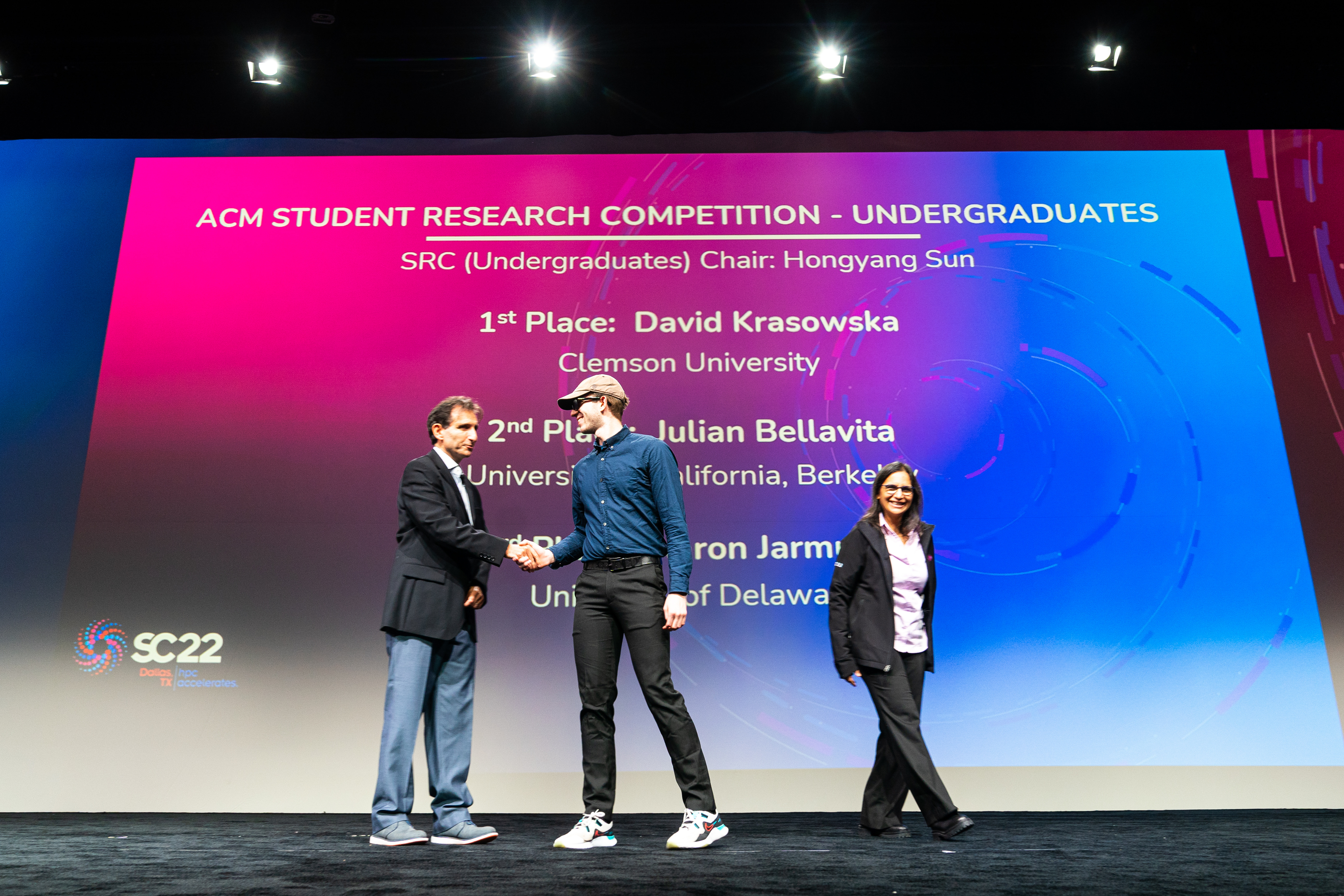
My background.
[outdated June 2024.]
I am a Computer Science Ph.D. candidate at Northwestern University under Dr. Peter Dinda and a recipient of the Department of Energy Computational Science Graduate Fellowship. Currently, my focus is data-centric computing and processing near memory for domain specific applications. This focus is part of the Constellation Project which enables frictionless heterogeneous parallelism. My research introduction began with research within the FTHPC group at Clemson University under Dr. Jon C. Calhoun. Within this group, I collaborated with Argonne National Laboratory as a visiting student on lossy data compression research. Our goal was to determine different statistical predictions that would allow for estimation of lossy compression ratios. This had lead to publications and awards. Also, I participated in the Student Cluster Competition at Super Computing (SC) ’21 and INDYSCC at SC '22.
I am a Computer Science Ph.D. candidate at Northwestern University under Dr. Peter Dinda and a recipient of the Department of Energy Computational Science Graduate Fellowship. Currently, my focus is data-centric computing and processing near memory for domain specific applications. This focus is part of the Constellation Project which enables frictionless heterogeneous parallelism. My research introduction began with research within the FTHPC group at Clemson University under Dr. Jon C. Calhoun. Within this group, I collaborated with Argonne National Laboratory as a visiting student on lossy data compression research. Our goal was to determine different statistical predictions that would allow for estimation of lossy compression ratios. This had lead to publications and awards. Also, I participated in the Student Cluster Competition at Super Computing (SC) ’21 and INDYSCC at SC '22.
What is my research proposal?
The end of Moore’s law has resulted in development of new specialized architectures for computing [3]. There has been countless prior work in the area of increasing computational
speed using processing in memory (PIM) accelerators. However, there are a few issues that require a demanding amount of work for adoption for these newer ideas.
This is due to the general approach taken and requiring domain scientists to rewrite their code with directives in order to make use of this functionality.
I have an interest in designing a PIM system for HPC domain specific applications. I would like to focus on HPC infrastructures; however, this approach would generalize to other infrastructures, such as data centers. Data centers are used all over the world and utilize lots of valuable resources/energy. Improving data center architecture and programmability can reduce the environmental footprint. Northwestern has multiple labs working towards the goal of optimizing performance in computing systems. I am currently working with the Prescience lab that focuses on optimizing higher level code to reduce programmer intervention. My goal is to take high level languages that are popular within a specific domain and automatically detect parallel code to generate PIM instructions. Using today’s PIM hardware, I expect to be able to develop a software approach to achieve this goal. I can leverage my group's compiler and language expertise in pursuit of the goal. This approach would allow domain scientists to keep their high level code and not spend time rewriting it for the new system. Based on my experience in the software approach, I will next consider improvements to hardware design. This plan will hopefully lead to increased performance and allow for less energy consumption, thus improving efficiency and environmental impact.
I have an interest in designing a PIM system for HPC domain specific applications. I would like to focus on HPC infrastructures; however, this approach would generalize to other infrastructures, such as data centers. Data centers are used all over the world and utilize lots of valuable resources/energy. Improving data center architecture and programmability can reduce the environmental footprint. Northwestern has multiple labs working towards the goal of optimizing performance in computing systems. I am currently working with the Prescience lab that focuses on optimizing higher level code to reduce programmer intervention. My goal is to take high level languages that are popular within a specific domain and automatically detect parallel code to generate PIM instructions. Using today’s PIM hardware, I expect to be able to develop a software approach to achieve this goal. I can leverage my group's compiler and language expertise in pursuit of the goal. This approach would allow domain scientists to keep their high level code and not spend time rewriting it for the new system. Based on my experience in the software approach, I will next consider improvements to hardware design. This plan will hopefully lead to increased performance and allow for less energy consumption, thus improving efficiency and environmental impact.
[1] A. Petitet, R. Whaley, J. Dongarra, and A. Cleary, ‘HPL – a Portable Implementation of the High-Performance Linpack Benchmark for Distributed-Memory Computers’, 01 2008.
[2] P. Giannozzi et al., ‘QUANTUM ESPRESSO: a modular and open-source software project for quantum simulations of materials’, Journal of Physics: Condensed Matter, vol. 21, no. 39, p. 395502, Sep. 2009.
[3] T. N. Theis and H. . -S. P. Wong, "The End of Moore's Law: A New Beginning for Information Technology," in Computing in Science & Engineering, vol. 19, no. 2, pp. 41-50, Mar.-Apr. 2017, doi: 10.1109/MCSE.2017.29.
[2] P. Giannozzi et al., ‘QUANTUM ESPRESSO: a modular and open-source software project for quantum simulations of materials’, Journal of Physics: Condensed Matter, vol. 21, no. 39, p. 395502, Sep. 2009.
[3] T. N. Theis and H. . -S. P. Wong, "The End of Moore's Law: A New Beginning for Information Technology," in Computing in Science & Engineering, vol. 19, no. 2, pp. 41-50, Mar.-Apr. 2017, doi: 10.1109/MCSE.2017.29.